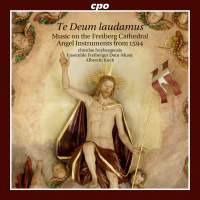Texte paru dans: / Appeared in: |
|
|
|
|
|
Reviewer: Barry
Brenesal When Duke Henry of Saxony took up residence in Freiburg in 1505, he began an enhancement project of the trade city’s recently rebuilt cathedral. His son Heinrich was a Lutheran convert who moved to Dresden, but Freiburg Cathedral came to hold an esteemed place in the lore of those Albertine Wettin rulers: All their descendants were buried there, until the line converted back to Catholicism in 1697. (That move was made by that extravagant lover of the arts, Augustus I, Elector of Saxony, who commissioned Heinichen’s La gara degli dei, reviewed in Fanfare 37:3. You can’t get away from the music.) In the 1530s it merged with several educational institutions, at one time having in its charge more than 1,000 students; and in keeping with the relatively moderate Lutheran views of its rulers, provided a range of sacred music that embraced the works of contemporary Roman Catholic composers provided they followed some theological rules. This album explores works stored there in manuscript that are seldom unica, but do display handwritten changes made for local use. In practice, though, religious institutions of the day regularly adjusted key (not mode), textures, and even words to suit their local needs. Still, not much of this music is easily attainable elsewhere on disc, so versions based on standard printed collections would be more welcome to serve as a yardstick against which to measure differences. The centerpiece of these proceedings is Philippe de Monte’s Missa Mon cœur se recommande à vous. Its five movements are preceded and followed as though in sacred performance by a series of motets, of which the most distinctive is Rogier Michael’s Te Deum laudamus: Sex vocibus, alternating line-by-line a German translation of its text with the Latin, soloist with choir, simplified Gregorian hymn with largely homophonic textures and sprung rhythms. Much of the rest of the program is more musically conservative, with highly imitative textures, canons, and the panoply of Franco-Flemish polyphony utilized to fine effect. By the mid-16th century many better supported religious centers began adding instruments to some aspects of the service, sometimes doubling parts, or replacing voices as time went on, though much was left unwritten and to the discretion of the Kapellmeister. The practice became more extensive, and finds its greatest expression here in the Cantate dominum of Fabricius. By then, the individual instruments were labeled as they entered. Much is made in the liner notes of all the care that was taken by the Freibergers to measure, document, and copy the 30 instruments left in the cathedral in the late 16th century—literally placed in the hands of golden angels hovering over 39 feet above ground—through a long-term research project begun in 2005, and headquartered in the Georg Kinsky Institute of Musical Instrument Research at Leipzig University. What is ironic in all this is that numerous selections on this album attest to the use of boy trebles and altos, such as the Cathedral’s copy of da Monte’s Missa Mon cœur se recommande à vous having higher parts transcribed further upwards. Yet the Freiburg Cathedral Music Ensemble, which handles the vocal side of matters here, employs adults (an alto countertenor and a pair of female sopranos) for those same parts. Exactingly crafted instrumental copies to one side, the sound we have here certainly wasn’t what the Freiburgers would have heard back then, and renders claims of authenticity beside the fact. Nor do the vocal performances match up to the highest standards. Individually, per soloist, they are all exceptional, but as a unit they fail to provide either reasonably balanced, constantly lucid textures, or part dynamics within phrases that vary sufficiently according to the needs of the music: false relationships, underscored harmonic progressions, successive imitative textures, etc. It doesn’t help that there are occasional brief pitch issues, most notable where the instruments are missing, as in Lechner’s Si bona suscepimus di manu Domini; nor that there’s a false start at the beginning of the Kyrie, with the alto entering a split second behind the instruments on the same note. Granted, Albrecht Koch only founded the FCME in 2013, and a lack of studio time may also need to be factored in; but their part of the proceedings is less pleasurable than it might have been. The seven instrumentalists of chordae freybergensis (yes, another one of those ensembles that recognizes the primacy of pre-Baroque music even as it denies the existence of capital letters) are better, overall. They utilize some of those copies of cathedral instruments—admittedly in more of a background contributive effort than the prominent role given them in, say, contemporary late 16th-century Venetian sacred music, but that’s to be expected; and they perform expertly, meshing well with the FCME. (The engineering blend is actually one of the stronger features on this album.) Albrecht Koch, who performs as organist with them, also is credited with conducting the entire effort. He manages his forces effectively, and with a good sense of style, providing impressive rhythmic precision in more syllabic passages.
Worth buying?
For the music, and the instrumentalists, but not for the poor timing, or the
vocalists. Check the album out online or in a store, and see whether you
agree or not. | |
|
|
|
|
|
|
|
Cliquez l'un ou l'autre
bouton pour découvrir bien d'autres critiques de CD |
|




